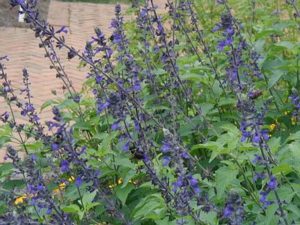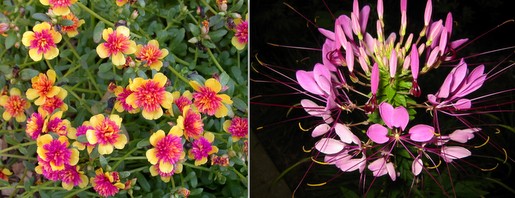Budget-Friendly Plants: Annuals that Spread by Seed
 My new garden in Old Greenbelt is far smaller than the one I left behind – that was the idea, after all. But though smaller, it’s still a brand new garden, and mostly empty. Calculating how much it would cost to fill it with perennials is discouraging, so I asked the staff at Behnkes to point out annuals that will fill up my garden next year, for no additional cost.
My new garden in Old Greenbelt is far smaller than the one I left behind – that was the idea, after all. But though smaller, it’s still a brand new garden, and mostly empty. Calculating how much it would cost to fill it with perennials is discouraging, so I asked the staff at Behnkes to point out annuals that will fill up my garden next year, for no additional cost.
And the good news is that there are lots of them. So here’s the batch I’m investing in this year – very little money – for an even big pay-off next year.
Salvia ‘Black and Blue’ and ‘Victoria Blue‘
These deep blue beauties are reliable self-sowers and great at attracting pollinators. Gardeners chatting on one large online forum agree that while not cold-hardy, they definitely come back each year from seed.
Again, the forums are full of reports of this annual spreading by seed. Also reported is the tip that now’s the time to “pinch and poke” any impatiens that may be getting leggy about now (late June through mid-July). Just know that next year’s impatiens may be a different color than this year’s.
Now who can resist the combination of long-haired cat and red impatiens shown in this photo? Or honestly, this cat with anything – he’s awesome!
Portulaca
This Brazilian succulent is unusually drought-tolerant among annuals, so great for the low-maintenance gardener. They’re available in a range of bright colors and when young, they’re even edible.

Cleome
Cleomes are unusual among annuals for their height – 36 to 72 feet by mid-summer – and for their wonderful sparkler-type shape. Commonly named Spider Flower, they’re quite heat-tolerant, and loved by both birds and butterflies.
Marigolds

Marigolds are practically a staple in vegetable gardens because they naturally repel nematodes and other garden pests, including rabbits, deer and rodents. They’re often seen planted along rows of tomatoes, eggplants, peppers and potatoes, to good effect. Yet miraculously, they attract the bugs we like – butterflies.
And all but the most hybridized varieties of marigolds are reliable self-seeders, especially if you deadhead the blooms and drop them onto the ground.
Interestingly, marigolds are by far the most popular flower throughout India, Nepal and Thailand for making the garlands that are ever-present in religious rituals.
Posted by Susan Harris. Photo credits. Salvia. Impatiens with cat. Portulaca. Cleome. Marigolds in garden. Marigolds in Nepal.


This Post Has 0 Comments